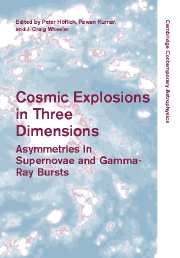Book contents
- Frontmatter
- Contents
- Part I Introduction
- Part II Supernovae: Observations Today
- Part III Theory of Thermonuclear Supernovae
- 10 Semi-Steady burning evolutionary sequences for CAL 83 and CAL 87: Super Soft X-ray binaries are supernova Ia progenitors
- 11 Type Ia progenitors: effects of spin-up of white dwarfs
- 12 Terrestrial combustion: feedback to the stars
- 13 Non-spherical delayed detonations
- 14 Numerical simulations of Type Ia supernovae: deflagrations and detonations
- 15 Type Ia supernovae: spectroscopic surprises
- 16 Aspherity effects in supernovae
- 17 Broad lightcurve SNe Ia: asymmetry or something else?
- 18 Synthetic spectrum methods for three-dimensional supernova models
- 19 A hole in Ia? Spectroscopic and polarimetric signatures of SN Ia asymmetry due to a companion star
- 20 Hunting for the signatures of 3-D explosions with 1-D synthetic spectra
- 21 On variations in the peak luminosities of Type Ia supernovae
- Part IV Theory of Core Collapse Supernovae
- Part V Magnetars, N-Stars, Pulsars
- Part VI Gamma-ray Bursts
- Part VII Conference Summary
- References
13 - Non-spherical delayed detonations
Published online by Cambridge University Press: 11 August 2009
- Frontmatter
- Contents
- Part I Introduction
- Part II Supernovae: Observations Today
- Part III Theory of Thermonuclear Supernovae
- 10 Semi-Steady burning evolutionary sequences for CAL 83 and CAL 87: Super Soft X-ray binaries are supernova Ia progenitors
- 11 Type Ia progenitors: effects of spin-up of white dwarfs
- 12 Terrestrial combustion: feedback to the stars
- 13 Non-spherical delayed detonations
- 14 Numerical simulations of Type Ia supernovae: deflagrations and detonations
- 15 Type Ia supernovae: spectroscopic surprises
- 16 Aspherity effects in supernovae
- 17 Broad lightcurve SNe Ia: asymmetry or something else?
- 18 Synthetic spectrum methods for three-dimensional supernova models
- 19 A hole in Ia? Spectroscopic and polarimetric signatures of SN Ia asymmetry due to a companion star
- 20 Hunting for the signatures of 3-D explosions with 1-D synthetic spectra
- 21 On variations in the peak luminosities of Type Ia supernovae
- Part IV Theory of Core Collapse Supernovae
- Part V Magnetars, N-Stars, Pulsars
- Part VI Gamma-ray Bursts
- Part VII Conference Summary
- References
Summary
Abstract
Delayed detonations in exploding carbon-oxygen (C-O) white dwarfs, are bound to ignite and propagate in an expanding Rayleigh-Taylor (R-T) unstable region. Therefore, non-spherical detonations are expected to evolve due to a possible off-center ignition and due to the inhomogeneous composition ahead of the detonation front. We examine some of the possible consequences of such non-spherical explosions, using two-dimensional axisymmetric simulations.
We find that the explosion products, namely the amount of energy released and the composition of the burnt material, are rather sensitive to the asphericity. This sensitivity follows from the fact that the expansion speed is not negligible with respect to the detonation speed. With lower transition density we get less Fe group elements, smaller explosion energy and higher asphericity in the distribution of elements. We also show that the delayed detonation cannot directly induce a second detonation in a nearby isolated bubbles or channels of cold fuel. Therefore, pockets of unburnt C-O mixture may survive deep inside the ejecta.
Introduction
The delayed detonation model for Type Ia supernovae assumes that transition from deflagration to detonation occurs during the combustion of a carbon oxygen (C-O) Chandrasekhar mass white dwarf. In order to fit observations, the transition should occur after a significant expansion that reduces the density of the fuel ahead of the front. Traditionally, the transition point is parametrized by a transition density ρtr, which is the density ahead of the deflagration front at the transition moment.
- Type
- Chapter
- Information
- Cosmic Explosions in Three DimensionsAsymmetries in Supernovae and Gamma-Ray Bursts, pp. 110 - 120Publisher: Cambridge University PressPrint publication year: 2004
References
- 3
- Cited by

